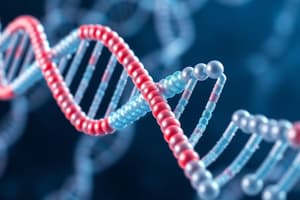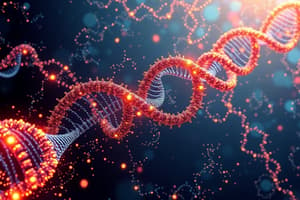Podcast
Questions and Answers
Which type of colonies indicate the presence of a recombinant plasmid in blue-white screening?
Which type of colonies indicate the presence of a recombinant plasmid in blue-white screening?
- White colonies (correct)
- Blue colonies
- Yellow colonies
- Green colonies
What is the role of restriction enzymes in producing human insulin in bacteria?
What is the role of restriction enzymes in producing human insulin in bacteria?
- To synthesize insulin directly in bacteria
- To transform bacteria with foreign DNA
- To enhance the growth of bacteria
- To cut DNA and plasmids for gene insertion (correct)
What happens to bacteria without recombinant plasmids when grown on X-gal media?
What happens to bacteria without recombinant plasmids when grown on X-gal media?
- They produce white colonies
- They transform into a mutant form
- They produce blue colonies (correct)
- They cannot grow at all
Which of the following describes the purpose of blue-white screening?
Which of the following describes the purpose of blue-white screening?
In the context of insulin production for Type-I Diabetes, what is the main challenge addressed?
In the context of insulin production for Type-I Diabetes, what is the main challenge addressed?
What characterizes a recombinant plasmid?
What characterizes a recombinant plasmid?
What is the primary function of restriction enzymes in genetic engineering?
What is the primary function of restriction enzymes in genetic engineering?
Which characteristic is true about plasmids?
Which characteristic is true about plasmids?
What defines a vector in genetic engineering?
What defines a vector in genetic engineering?
What is a viral vector?
What is a viral vector?
How do restriction enzymes create 'sticky ends'?
How do restriction enzymes create 'sticky ends'?
What is the purpose of using plasmids in recombinant DNA technology?
What is the purpose of using plasmids in recombinant DNA technology?
What happens when a restriction enzyme cuts DNA?
What happens when a restriction enzyme cuts DNA?
Which method is commonly used in biotechnology to transfer genes into bacteria?
Which method is commonly used in biotechnology to transfer genes into bacteria?
What is a characteristic of shuttle vectors?
What is a characteristic of shuttle vectors?
What is the primary purpose of PCR in biotechnology?
What is the primary purpose of PCR in biotechnology?
Which component is essential for the annealing step in PCR?
Which component is essential for the annealing step in PCR?
What property of Thermus aquaticus's DNA polymerase makes it suitable for PCR?
What property of Thermus aquaticus's DNA polymerase makes it suitable for PCR?
During which step of PCR is the DNA double helix separated?
During which step of PCR is the DNA double helix separated?
What is formed from mRNA in reverse-transcription PCR?
What is formed from mRNA in reverse-transcription PCR?
How many times does the DNA quantity double in PCR after each round of copying?
How many times does the DNA quantity double in PCR after each round of copying?
Which of the following is NOT one of the four essential items needed to perform PCR?
Which of the following is NOT one of the four essential items needed to perform PCR?
What are nucleotides in the context of PCR?
What are nucleotides in the context of PCR?
Which of the following describes the overall objective of biotechnology?
Which of the following describes the overall objective of biotechnology?
What is the role of salt and buffers in PCR?
What is the role of salt and buffers in PCR?
What happens to DNA during the extension step of PCR?
What happens to DNA during the extension step of PCR?
What is the significance of cooling DNA to 60 ⁰C in PCR?
What is the significance of cooling DNA to 60 ⁰C in PCR?
What is the process by which DNA quantity increases in PCR?
What is the process by which DNA quantity increases in PCR?
Which temperature is optimal for DNA polymerase activity in PCR?
Which temperature is optimal for DNA polymerase activity in PCR?
Which of the following components is NOT involved in polymerase chain reaction (PCR)?
Which of the following components is NOT involved in polymerase chain reaction (PCR)?
What type of DNA synthesis involves building genes using a synthesis machine?
What type of DNA synthesis involves building genes using a synthesis machine?
Which method allows for fast and cheap sequencing using synthetic labeled nucleotides?
Which method allows for fast and cheap sequencing using synthetic labeled nucleotides?
Which step is not part of the PCR cycle?
Which step is not part of the PCR cycle?
What is the main function of vectors in genetic engineering?
What is the main function of vectors in genetic engineering?
What is the outcome of a successful PCR process after repeating all steps numerous times?
What is the outcome of a successful PCR process after repeating all steps numerous times?
What is the primary function of a viral vector in gene transfer?
What is the primary function of a viral vector in gene transfer?
Which method involves removing cell walls from bacteria to facilitate gene transfer?
Which method involves removing cell walls from bacteria to facilitate gene transfer?
What does electroporation achieve in the context of DNA transfer?
What does electroporation achieve in the context of DNA transfer?
Which gene transfer method uses a device that shoots DNA-coated particles into cells?
Which gene transfer method uses a device that shoots DNA-coated particles into cells?
What is one limitation of viruses regarding replication?
What is one limitation of viruses regarding replication?
In the context of biotechnology, what does 'transformation' refer to?
In the context of biotechnology, what does 'transformation' refer to?
What occurs to viral DNA after it is incorporated into a host's genome by a viral vector?
What occurs to viral DNA after it is incorporated into a host's genome by a viral vector?
Which method for transferring DNA directly injects genetic material into a cell?
Which method for transferring DNA directly injects genetic material into a cell?
Which of these is NOT a way to transfer DNA into cells?
Which of these is NOT a way to transfer DNA into cells?
What is created when a gene of interest is spliced into the viral DNA of a viral vector?
What is created when a gene of interest is spliced into the viral DNA of a viral vector?
Flashcards are hidden until you start studying
Study Notes
Restriction Enzymes
- Cut DNA at specific recognition sites
- Cut both DNA strands
- Create "sticky ends" which are overhanging ends that are complementary to each other
- Restriction enzymes can create "sticky ends" in both source and vector DNA. This creates complimentary ends.
- The same restriction enzymes can be used to cut both source and vector DNA.
Recombinant DNA Technology
- Uses restriction enzymes to create recombinant plasmids.
- Recombinant DNA plasmids are created by inserting a gene from one organism into another via a plasmid.
- Plasmids can move into and out of bacterial cells.
- Plasmids replicate, transcribe, and translate independently of the bacterial chromosome.
Vectors
- "Vehicles" used to transfer DNA from a source to a target cell.
- Vectors must be able to self-replicate.
- Shuttle vectors exist in different species and can move cloned sequences among various organisms.
- Two common types of vectors are plasmids and viral vectors.
Plasmids
- Natural "free-floating" circular DNA.
- Double stranded DNA.
- Replicated, transcribed, and translated once in bacteria.
- Can be inserted into bacterial cells.
- Resistance plasmids provide resistance to certain antibiotics.
Viral Vectors
- "Disabled" viruses used to infect cells and transfer DNA.
- Unable to reproduce but can still infect cells.
- Viral vectors are inserted into cells by spliced into the viral DNA.
- The DNA is then incorporated into the host genome and transcribed and translated by the host cell.
5 Additional Ways to Transfer DNA into Cells
- Transformation: Cells take up DNA from the surrounding environment.
- Protoplast Fusion: Removing cell walls from two bacteria allows them to fuse.
- Electroporation: Introducing DNA into bacteria or other cells using electrical pulse to briefly open the pores in the cell membranes.
- Gene Gun: Uses elemental particles of a heavy metal coated with DNA to deliver exogenous DNA to cells.
- Microinjection: Uses a glass micropipette to inject foreign DNA into a cell.
Polymerase Chain Reaction (PCR)
- Rapidly copies DNA samples.
- Results in millions or billions of DNA copies in 1 hour.
- Used for creating millions of gene copies for:
- Transgenic and forensic biology.
- Diagnostic tests for genetic diseases.
- Detecting pathogens.
- Studying gene function.
- Reverse-transcription PCR uses mRNA as a template and a reverse transcriptase enzyme.
- Creates cDNA (complimentary DNA) - a complimentary DNA strand from an mRNA sequence.
PCR Requirements
- DNA: The DNA to be amplified.
- Primer: A short DNA sequence complementary to the beginning of a DNA sequence of interest.
- DNA Polymerase: An enzyme that adds nucleotides.
- Nucleotides: dtp's: dtpA, dtpT, dtpC and dtpG (dtp = deoxyribose tri-phosphate)
- Salt and buffers.
PCR Steps
- Denature DNA: Heat DNA to 95⁰C to separate double stranded DNA.
- Anneal Primers: Cool DNA to 60 ⁰C, primers will anneal to the DNA sequence by base pairing.
- Extension of DNA: Heat DNA to 72 ⁰C, DNA polymerase extends the primer, creating a copy of the DNA.
Synthetic DNA
- Builds genes using a DNA synthesis machine.
- Nucleotides, primers, and genes can be easily synthesized.
- Synthetically labeled nucleotides are used in next-generation sequencing, which is a fast and cheap method of sequencing.
Blue-White Screening
- A method for selecting recombinant plasmids.
- White colonies: Recombinant DNA colonies, the plasmid contains an inserted gene.
- Blue colonies: Non-recombinant cells, the plasmid does not contain an inserted gene.
Human Uses for Transgenic Biology
- Gene Therapy: Replacing defective or missing genes.
- Transgenic Bacteria: Growing human enzymes and other proteins in bacteria, such as insulin.
Producing Human Insulin in Bacteria
- Bacteria can be used to produce human insulin.
- Type 1 diabetes is caused by the pancreas not making enough or any functional insulin.
- Insulin is a protein hormone that signals cells to bring glucose into the blood.
- Transgenic insulin procedure:
- Restriction enzymes are used to cut the human insulin gene out of the donor cell and also to cut the plasmid.
- The gene is then inserted into the plasmid.
- The modified plasmid is then introduced into bacteria.
- The bacteria will produce the human insulin protein.
Gene Silencing
- Gene silencing is a process that can be used to block the expression of a specific gene.
- Gene silencing has been used to develop new treatments for various diseases, including cancer.
Studying That Suits You
Use AI to generate personalized quizzes and flashcards to suit your learning preferences.




